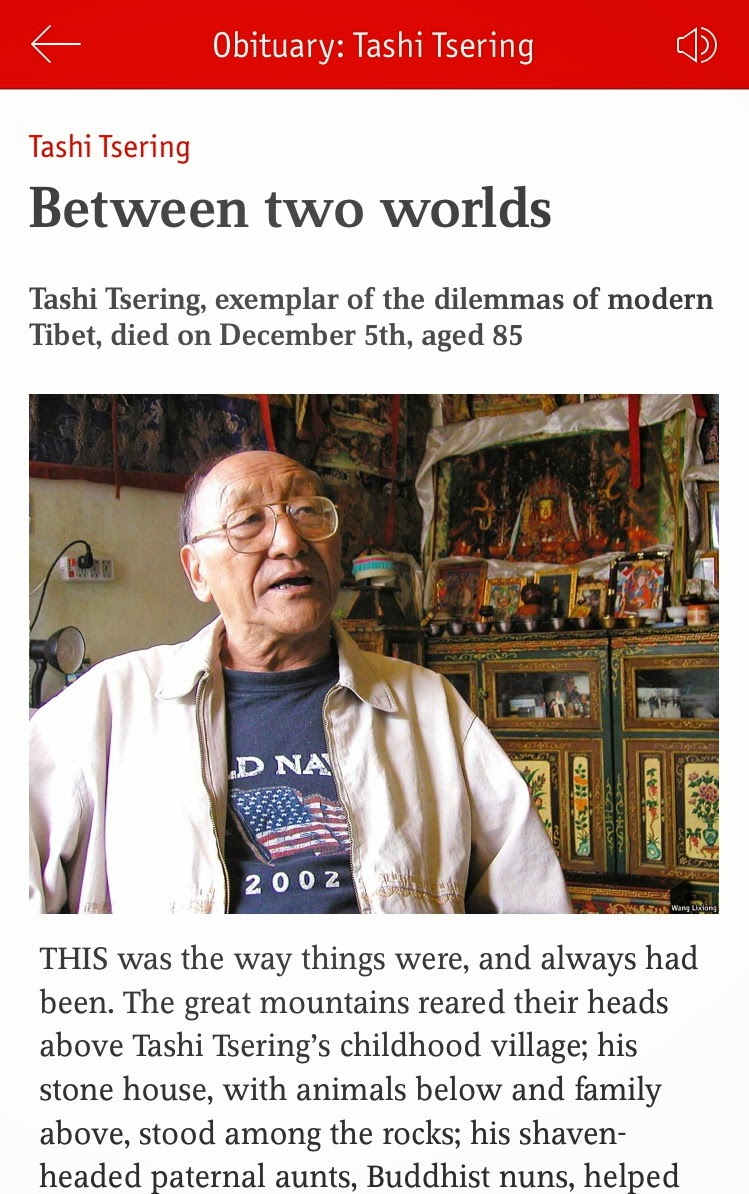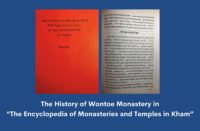
High Peaks Pure Earth has translated a blogpost by Woeser written in December 2014 for the Mandarin service of Radio Free Asia and published on her blog on December 26, 2014.
Woeser’s post is a response to this obituary of Tashi Tsering published in The Economist on December 20, 2014: http://www.economist.com/news/obituary/21636703-tashi-tsering-exemplar-dilemmas-modern-tibet-died-december-5th-aged-85-between
Tashi Tsering’s 1997 autobiography “The Struggle for Modern Tibet” is still essential reading for watchers of contemporary Tibet. The book was also published in Chinese under the title of “Tibet Is My Home” in 2006 by the China Tibetology Publishing House.
“The Economist’s Simplification of Mr. Tashi Tsering”
By Woeser
On December 5, 2014, the famous Tibetan intellectual, Mr. Tashi Tsering, passed away. 15 days later, “The Economist” published an obituary. They contacted me to ask for a photo that my husband, Wang Lixiong, had taken of Mr. Tashi Tsering 10 years earlier. The photo shows Mr. Tashi Tsering forward-facing, looking self-confident as he speaks. His T-shirt and khaki jacket give him a fashionable and energetic aura. At the time he was already 75 years old.
A friend translated the obituary for me. After reading it I was somewhat astonished. As a Tibetan (a modern Tibetan) who has known Mr. Tashi Tsering for 30 years, I felt that this obituary was badly-written. It was like an English translation of a Chinese party media propaganda piece, presenting Tsering as a key figure in the “serf liberation” movement, and depicting the revolutionary and “modernised” CCP as a “liberator” who did not take “as much as a needle” from the people. Apart from making a few unavoidable mistakes, the Chinese eventually “emancipated” Tibet, bringing about “not liberty, but equality”. I am really not sure how “The Economist” understands “liberty” and “equality”; every prisoner on death row is equal in the face of death…
The obituary uses parts of Mr. Tashi Tsering’s autobiography, but completely out of context, only mentioning his initial enthusiasm for the CCP, not his later changes. It makes it look as if Mr. Tashi Tsering was still 20 or 30 years of age, but not a 85-year-old man. In fact, if one takes parts of the autobiography of the Dalai Lama, one might also get the impression that he worshipped Mao Zedong his entire life. The obituary even misinterprets a quote in the autobiography; it is a quote of a Tibetan aristocrat (in fact, it is the Dalai Lama’s second-eldest brother, Mr. Gyalo Thondup), saying that Tibetans separate into two kinds, “those who’ll eat tsampa [roast barley meal, stirred into salty tea] and those who’ll eat shit”. In reality, this sentence means: One group of Tibetans identifies with their own ethnic groups, so they are referred to as “eating tsampa”; a second group sells Tibetan livestock for profit, so they are referred to as “eating shit”. Of course, we all know that “tsampa” is not only referring to Tibet’s special grain crop: roast barley. In Tibetan culture, tsampa also stands for certain ethnic qualities, signifying ethnic identity; asking “do you eat tsampa?” is like asking “are you Tibetan?” This is also why every time when protests erupt, people will shout: “all tsampa eaters, come out!”
By no means am I trying to be too picky or demand “The Economist” to agree. It is well-known that “The Economist” is “cool”, reluctant to give compliments or admit mistakes. It is said that the most positive statement that the magazine ever made about the Tibetan exiled government is that it is the most serious one in the world. So I was certainly surprised when I received an email from the senior editor of “The Economist” and author of the obituary, Ann Wroe. She explained the entire piece, including the fact that the descriptions of how Mr. Tashi Tsering felt during different time-periods were all taken from his autobiography. But the autobiography was completed in 1996 when Tsering was only 67 years of age; I feel that an obituary must not pass judgement, unless it is based on someone’s entire life.
I do not want to call “The Economist” naive; rather, my point is that Tashi Tsering is an extremely complex person – just as the subheading of the obituary reads: “Tashi Tsering, exemplar of the dilemmas of modern Tibet…” – regardless of whether we look at his life, his fate, his pioneering thoughts or his exceptional deeds, we can never simplify or formalise him. Perhaps, Ann Wroe has never actually met Tashi Tsering; or if she has, it must have only been briefly.
After I heard of Mr. Tashi Tsering’s death, I spent ten full days to re-read his oral accounts that were recorded and published in two volumes by American scholars: one of them is called “The Struggle for Modern Tibet: The Autobiography of Tashi Tsering” and recounts his life in “the old” and in “the new Tibet”, including his time studying in India and the United States. The other one is called “The Struggle for Education in Modern Tibet: The Three Thousand Children of Tashi Tsering”, which starts in his home village and follows Mr. Tashi Tsering in setting up many primary and occupational schools in rural Tibet. I also took out the many photos that I had taken of him during our many encounters over the past years; I also found Wang Lixiong’s diaries of his conversations with Tsering. I began writing an article about him. I wrote incessantly until I had more than 8000 characters but still felt that I had not written enough, that I had only scratched on the surface. In fact, many years ago, I already wrote a piece about him. But I didn’t know him yet, which is why I finished the essay writing: “If I ever get the chance to meet this wise man, I will ask him one question: even though the ‘officials of the old Tibet’ excluded a ‘Tibetan nationalist’ like he was, the new Tibet locks an enthusiastic person like him up in prison; how does he make out which one of those two “fates” is the more sorrowful one?”
In my recent long essay that I just finished writing, I describe Mr. Tashi Tsering as follows: “This former independent and self-sufficient farmer grew up in a torn state of mind that he was unable to resist against” “…Born in a Tibetan village, his ‘desire for knowledge’ was endless; his trip to Lhasa as a young boy was a turning point; later he went to India to learn English and also to the US where he ‘studied like a madman’ and was exposed to ‘naive and silly optimism’; so when he returned home in 1964, he clung on to his course, eager to bring his acquired knowledge to the drastically transformed Tibet; he wanted to ‘help my fellow compatriots living under communism’; but the so-called “liberated Tibet” was like Xianyang Bridge described thousands of years ago by the Tang dynasty poet Du Fu, ‘disappearing as dust clouds swell.’”
The fact is that Mr. Tashi Tsering returned from the US in his prime time, at the age of 35, and was only allowed to return to Lhasa at the age of 52; in between, he was convicted as an “American spy” and “a Tibetan separatist” and locked up in Xianyang, Changwu and Lhasa prisons for a total of five years and seven months; it was not as “The Economist” wrote, that he had been immured for 11 years; and this information can clearly be found in his autobiography. Ann Wroe explained this by stating that she included the time that Mr. Tashi Tsering was under house arrest; nevertheless, the wording in the article is imprecise and does not conform to the truth. After being released from jail, for the remaining years, he was being watched, stigmatised, brainwashed, denounced, locked up in cow sheds, imprisoned and driven into forced labour; he had to actively participate in the Cultural Revolution, followed the Red Guards to Beijing to worship Mao Zedong, went to Lhasa to “share his experiences of the Cultural Revolution” and many other similar things. The time he wasted and suffered beyond belief added up to a total of 17 years. How many 17 years do we have in our life? How many 17 years of “no liberty, but equality” do we really have?
I am not criticising “The Economist” or other accounts that simplify the life of Mr. Tashi Tsering out of pure emotions. I am 36 years younger than him, I was born and raised in the “liberated” “new Tibet”, I belong to a totally different group of Tibetans and should not really agree with his ideals. And yet, why did I, 13 years ago, excitedly read his autobiography in one go? Why did I go and visit him, listen to his ideals and dreams that were attacked again and again without him ever giving in, with him keeping up the struggle? Why did I gain an understanding and feeling for the “old” and “new Tibet” from this, which helped me change my mind about some wrong ideas that I had been brainwashed into believing? I know exactly that on a very fundamental level, me and Tashi Tsering share the same emotion: “Tibet is not simply an idea or a word; it is a place – my home”.
I would really like to tell “The Economist” and many other people a story; it is a true story that happened 3 years before Tashi Tsering passed away, and I believe that it illustrates “Tibet’s current dilemma” better than any report. Of course, it is a story taken from the article that I wrote for him:
“In the summer of 2011, Wang Lixiong and I returned to Lhasa, after a round through the Barkhor, we directly went to Mr. Tashi Tsering’s home, he had just received a few guests and was wearing a blue jacket, he looked well and energetic. He went to find a sheet of paper for us to read; in Tibetan, Chinese and English it said: ‘Tashi Tsering Education Fund”. He was happily waving with his hands, saying ‘Tashi Tsering’s dream is that all Tibetan children can go to school and study, I have been struggling for a long time and now I have had some success, my documentary was recently broadcast on CCTV 4.’ However, as we were saying goodbye, he suddenly hugged me, choking with tears, no longer proud and satisfied as before, his shivering old body exuded a kind of pain that I was unable to describe with words, I felt deeply shocked, didn’t know what to do. I muttered ‘Kaley Shu Ah,Kaley Shu Ah’ (Tibetan words of farewell) and left hastily; only when I was back in the bright sunlight and saw the streets full of Chinese tourists and military police, did I start to shed silent tears.
“Why did he cry? This strong man who has gone through so much suffering, who has maintained the firm belief and hope that his hometown and people can be modernised, while ‘also doing everything to safeguard our local language and cultural traditions’; is this man crying bitterly because his ideals are being shattered by grim reality? As I was leaving his home, looking back at Jokhang Square with tears in my eyes, I could see the roof of his home; since the protests of March 2008, two snipers with steel guns in their hands are being stationed there, day and night; it is like soldiers constantly trampling on Mr. Tashi Tsering’s head.”
— Until his death, these snipers continued to trample on his head; they did so for over six years.
December 23, 2014





Follow Us!